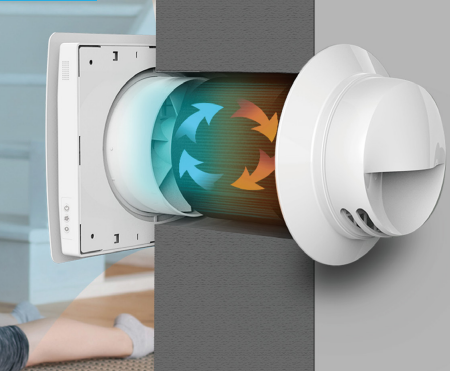Cost Savings of HRV for Homeowners
Wiki Article
How Heat Recovery Ventilation Boosts Indoor Air Top Quality and Reduces Energy Expenses
Heat Recovery Ventilation (HRV) systems play a crucial duty in improving indoor air top quality while all at once decreasing power expenditures. By efficiently trading stagnant interior air with fresh outside air, HRVs assist keep optimal moisture and decrease toxins. In addition, their capacity to recuperate warmth from outward bound air decreases the stress on home heating and cooling down systems. As power costs continue to increase, recognizing the complete capacity of HRV systems ends up being progressively crucial for house owners and companies alike.Comprehending Heat Recovery Ventilation Equipments

Heat recovery ventilation (HRV) systems play an important role in boosting interior air top quality, particularly in contemporary, energy-efficient buildings. These systems are made to transfer warmth from the outward bound stagnant air to the incoming fresh air, consequently decreasing energy loss while preserving perfect temperature degrees inside. HRVs include a heat exchanger, fans, and ductwork, helping with the continuous circulation of air. By expelling indoor toxins and presenting fresh air, HRVs aid to balance humidity levels, prevent mold and mildew growth, and minimize allergens. The efficiency of HRV systems hinges on their capability to recover up to 80% of the warmth from the worn down air, advertising energy conservation while ensuring a healthy indoor atmosphere. Their integration is essential in attaining lasting living techniques.
The Importance of Indoor Air Quality
Indoor air quality (IAQ) is an essential factor influencing the wellness and health of owners in any atmosphere. Poor IAQ can bring about various health and wellness concerns, consisting of respiratory problems, allergic reactions, and tiredness. Additionally, it can intensify present conditions such as bronchial asthma. Elements adding to low IAQ consist of toxins from interior resources like cleaning up representatives, mold and mildew, and poor ventilation. Consequently, keeping good IAQ is vital for promoting a risk-free and comfy living or functioning space. Effective methods to enhance IAQ include regular surveillance of air quality, correct air flow systems, and minimizing making use of dangerous substances indoors. By prioritizing IAQ, people can assure a much healthier atmosphere that promotes efficiency and total lifestyle.Power Effectiveness Advantages of HRV Solutions
Many property owners and structure supervisors are increasingly recognizing the energy efficiency advantages of heat recovery air flow (HRV) systems. By transferring heat from exhausted interior air to inbound fresh air, HRV systems substantially decrease the energy needed for cooling and heating. This process minimizes dependence on standard HVAC systems, causing reduced energy expenses. In addition, HRVs aid preserve a well balanced interior environment, avoiding excessive home heating or cooling needs. The ability to recover as much as 90% of the heat from outbound air also sustains sustainability efforts by decreasing total power consumption. HRV systems add not just to set you back savings however likewise to a reduced carbon footprint, lining up with the expanding focus on energy-efficient building techniques.Installment and Maintenance Considerations
The efficient implementation of warm healing ventilation (HRV) systems calls for careful consideration of installment and upkeep variables to guarantee peak efficiency. Appropriate positioning of the HRV unit is necessary, as it must be set up in a place that optimizes air flow while decreasing sound disruption. HRV Heat Recovery Ventilation Additionally, ductwork should be suitably sized and shielded to avoid power loss. Regular upkeep, consisting of filter substitute and system cleaning, is critical to protect optimal performance and indoor air top quality. Proprietors should develop a routine upkeep schedule to recognize and deal with possible issues prior to they escalate. Collaboration with skilled experts throughout both setup and maintenance phases can enhance the longevity and effectiveness of HRV systems, inevitably bring about much better indoor settings and decreased power costs.
Real-World Applications and Success Stories
Exploring real-world applications of warmth recuperation air flow (HRV) systems reveals their significant influence on interior air top quality and energy effectiveness throughout different setups. In residential buildings, homeowners have actually reported improved air quality, causing fewer allergies and respiratory concerns. Schools executing HRV systems have actually kept in mind enhanced trainee concentration and decreased absence as a result of far better air flow. Industrial structures, such as offices and retail rooms, have experienced lower power expenses and boosted staff member performance. A company workplace in a pleasant climate achieved a 30% decrease in energy bills after installing an HRV system. These success stories show that HRV modern technology not just adds to healthier settings however also provides concrete economic advantages, making it a valuable financial investment for different fields.Regularly Asked Inquiries
Can HRV Solutions Decrease Irritants in Indoor Air?
The effectiveness of HRV systems in decreasing interior allergens largely rests on their capacity to filter and exchange air. HRV Heat Recovery Ventilation. By constantly replacing stale air, these systems can substantially lower allergen levels throughout interior environments
How Does Moisture Affect HRV System Performance?
Moisture substantially affects HRV system efficiency; high degrees can result in condensation, minimizing performance, while reduced moisture might enhance air exchange. Stabilizing moisture is vital for optimal operation and preserving indoor air high quality.Are HRV Solutions Noisy During Procedure?
HRV systems can produce varying sound levels throughout operation, depending on their style and setup. Some systems run quietly, while others may create obvious sound, particularly at higher air flow setups or when badly preserved.What Is the Average Life-span of an HRV System?

Can HRV Equipments Be Made Use Of in All Environments?
HRV systems can be utilized in different climates, but their performance may vary - HRV Heat Recovery Ventilation. In severe temperature levels, adjustments or additional systems could be necessary to guarantee suitable performance and convenience while maintaining indoor air qualityReport this wiki page